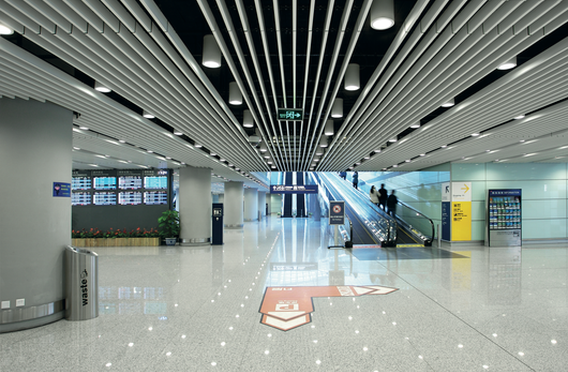10 considerations for improving visual adaptation in transport environments
Creating smooth lighting transitions
Transport hubs are bustling interchanges of movement and activity frequented by countless travellers every day. Lighting plays a vital role in helping to ensure their safe transit, but it can also pose challenges. This is often the case at transition zones between two adjacent spaces with divergent luminance levels.
Thorn effectively addresses these luminance variances with intelligent lighting schemes designed to enable easier visual adaptation for increased safety. In essence, they pave the way to smooth lighting transitions.
10 considerations for improving visual adaptation in transport environments
1. Understanding visual adaptation
The human eye is truly remarkable in its ability to see clearly at various distances and across a broad range of light intensities. However, when we quickly move from a dark to a brightly lit space, or vice versa, our sharpness of vision is briefly impaired, jeopardising our safety. That’s because the retina of the eye needs time to adjust to the differences in contrast or brightness levels.
Visual performance is dependent on the amount of available light. The higher the brightness level, the better our contrast sensitivity, our ability to perceive objects sharply within the field of view. Visual adaptation from dark to light therefore requires but a few seconds, whereas adjustment from light to dark generally takes longer. Contrast sensitivity is also diminished by glare, that is, by excessive brightness from a light source.
2. Transition zones
Fast-paced lighting transition zones with stark brightness contrasts in and around transport infrastructures pose visual challenges both for travellers and for vehicles. Typical examples include entrances and exits of buildings, corridors and underground passageways. Advanced lighting solutions are designed to mitigate sharp variances in brightness levels at these critical junctures, thereby facilitating visual adaptation for improved movement safety. With the multi-directional column Alumet Stage II and the floodlight LED Fit, Thorn offers two excellent solutions for building entrances and access areas.
3. Highlighting potential dangers
Stairs, ramps, escalators and other changes in elevation near transition zones can pose additional safety risks. It is of vital importance that they are appropriately highlighted to alert passengers of the potential dangers ahead and for better object recognition. LED accent lighting generally provides sufficient illumination for the task and, in combination with smart sensors, also saves energy during reduced traffic periods.
4. Embarking/disembarking interfaces
Transition zones with varying brightness levels are also common for embarking/disembarking points such as railway platforms, bus and tram stops, aircraft gates or quays at seaports. Lighting schemes employed here must be designed to enhance smooth visual transitions in support of safe passenger transfers between the means of transportation and the arrival/departure area.
5. Tunnels and underpasses
Operators of buses, shuttles and other ground transport vehicles frequently encounter critical transition zones at the entrances and exits of tunnels and underpasses. In addition to facilitating visual adaptation both at the point of entry and exit, the lighting system must also uphold brightness uniformity over the entire length of the passage as well as make adjustments in the interior zone, as needed, depending on the length of the tunnel. This calls for a differentiated lighting and control strategy, one that is also able to flexibly adapt brightness levels to changing lighting demands during the day and at night.
6. Outdoor workplaces
Lighting that supports good visual adaptation is equally imperative for the safe movement of trucks, forklifts and other support vehicles at outdoor workplaces such as hangars, warehouses and maintenance depots, particularly for guarding against accidents at the entrances. Areaflood Pro, a high-performance LED floodlight from Thorn, is ideal for illuminating outdoor perimeters.
7. Paths and walkways
Along footpaths and walkways leading to and from parking lots and adjoining buildings, visual adaptation of brightness levels serves to not only promote safe physical movement, but also a feeling of security. Lighting solutions like the D-CO Bollard and the wall-mounted luminaire Katona, both from Thorn, provide good visual guidance along pathways and building surrounds respectively. Customisation with time switches, photocells and motion detectors is also possible to reduce energy consumption.
8. Improving spatial orientation
Visual adaptation also plays an important role for our overall sense of direction and physical space. Orientation at transport complexes is of utmost importance for all travellers, not only for individuals with visual impairments or who are unfamiliar with a facility. No form of light has a more positive effect on our three-dimensional perception, spatial orientation and movement than natural light. For this reason, and to save energy costs, various types of transport architecture are increasingly combining daylight and artificial lighting sources, wherever possible. Layered lighting schemes, commonly used in many areas of transportation complexes, enhance overall visual differentiation, thereby also improving spatial orientation.
9. Round-the-clock adaptation
Large transport hubs such as train stations also operate largely around the clock. In these environments, visual adaptation is a constant, particularly at transition points involving natural daylight. Advanced lighting and control solutions can be customised to adjust luminance levels day and night in accordance with changes in available daylight, weather conditions and facility traffic – in other words, as needed.
10. Balancing varying lighting effects
Transportation environments as a whole utilise a variety of different lighting effects for different functions, ambiences and to differentiate between individual zones – direct lighting for guidance; indirect lighting in dining areas; accent illumination to highlight architectural elements; background illuminance in lounge and relaxation areas; natural daylight in open spaces and others. Modern transport lighting solutions balance divergent effects and brightness levels to allow for seamless visual adaptation when moving from one to the other. In short, they create smooth lighting transitions for a pleasant travel experience.

